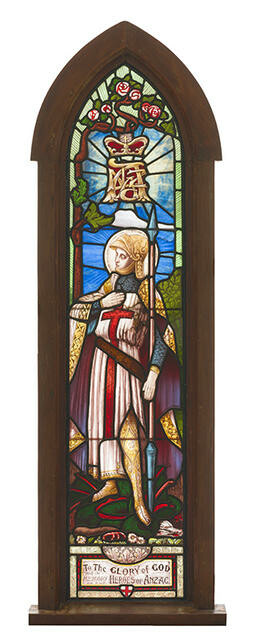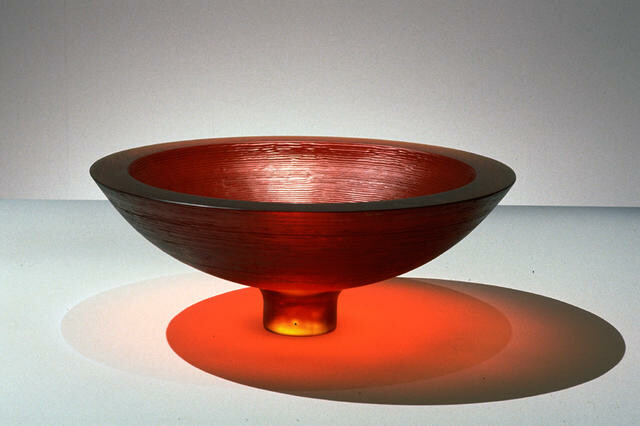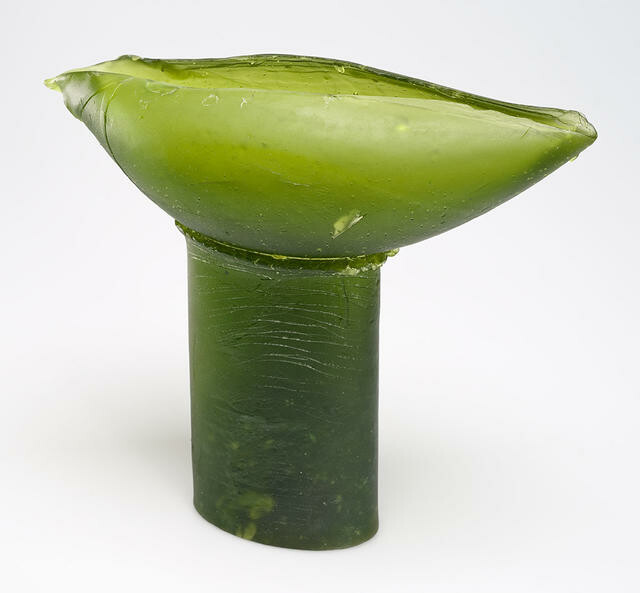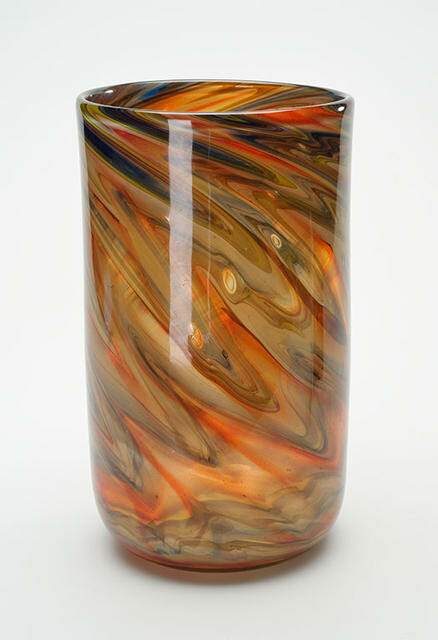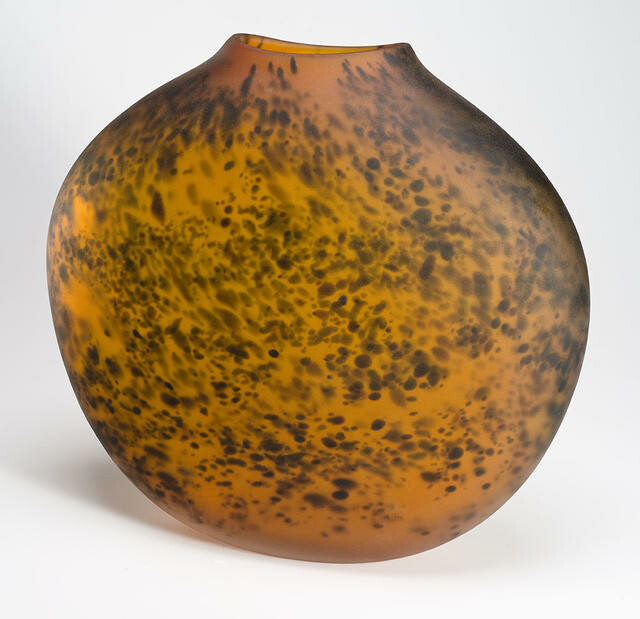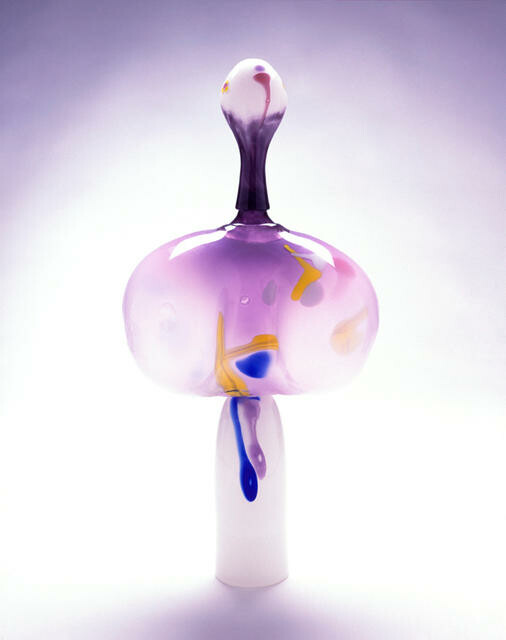B.
Captured Light The Glass Collection
Collection
From the intense luminosity and poignant evocation of traditional stained glass windows to the vivid colours, spectacular forms and mesmerizing surface textures achieved by many contemporary artists, glass is a rewarding medium for both creator and viewer. Currently numbering only twenty one items, the Gallery's glass holdings make up the smallest of the Collections, but range from historically important commemorative windows to contemporary pieces by some of New Zealand's most significant practitioners, who have consistently renegotiated the rules and boundaries of their chosen genre.
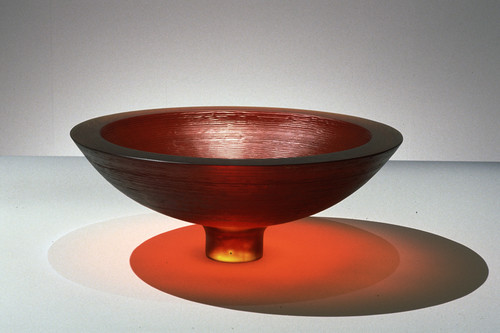
Ann Robinson Wide bowl 1999. Glass - 45% lead crystal. Collection of Christchurch Art Gallery Te Puna o Waiwhetū, purchased 1999
The contemporary works in the Collection fall within the category of Studio Glass, a movement originating in America in the early 1960s in which the artist controls the creative process from conception to execution, as opposed to the historical approach (practiced since the Industrial Revolution) where a work was conceived by a designer, then created by glassblowers within a large-scale factory environment. The history of Studio Glassmaking in New Zealand is relatively brief, but the Collection contains works that represent some of our most significant, and internationally recognized, practitioners. Upon his arrival in New Zealand from the United States in the mid 1970s, Tony Kuepfer brought with him hot glass blowing skills and knowledge of the necessary equipment. His presence, with that of fellow artist Mel Simpson, contributed to an increased interest in the hot glass medium amongst New Zealand artists. Kuepfer's works are particularly notable for their expressive use of vivid colour and highly sculptural form; attributes that are compellingly demonstrated in Violetta (purchased in 1983). In addition to this piece, the Gallery holds six other works by Kuepfer, which include bowls, vases, paperweights and a 'line drawing' on glass.
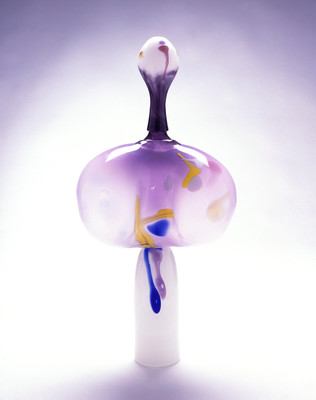
Tony Kuepfer Violetta 1983. Glass. Collection of Christchurch Art Gallery Te Puna o Waiwhetū, purchased 1983
Two major pieces currently represent the world-renowned glassmaker Ann Robinson in the Gallery's Collection. In addition to exhibiting widely within New Zealand and internationally, Robinson has taught at the prestigious Pilchuck Glass School in the United States. Wide Bowl (1999) illustrates both her mastery of the ciré perdu, or 'lost wax', process and her interest in how sculptural mass can suggest a sense of history, culture or place. One of only a few glassmakers using this technique to create vessels of such size, Robinson has described the process as " a modified form of bronze casting (in which) a wax blank is formed by pouring molten wax into a plaster base mould. This blank is then modified and re-invested in a second mould, made of refractory materials - that is, material which can withstand a long period in the kiln at high temperatures. After the wax is burnt out, the cavity is filled with molten glass. The glass mould is then cooled to room temperature. Larger pieces require up to three weeks cooling and one week finishing." Glass is an unforgiving medium - a mistake at any stage of this process would mean beginning again.
Robinson has consistently re-interpreted the bowl form, seeing it as a metaphor for human existence, since the same shape has been used for food and ceremonial purposes in almost every culture and time period (it is believed that glass vessels were first made from a heated mixture of sand, soda and lime during the Bronze Ageii). In Amphorae Nikau (purchased in 1993) specific reference is made to the shapes and colours of the nikau palm. The technique used is pate de verre (or 'glass paste') in which powdered glass is fired in a mould until it fuses, lending the object a semi-translucent quality. The work appears to both absorb and emit light, allowing Robinson to reflect the patterns of volume and space, and light and shadow present within the natural world, with the result that her works evoke a living, rather than static, presence. "My own personal poetry has always centred around a love of the natural world - the abstracted patterns of life and growth evolve their own symbolism", she has said.iii
Born in Australia, Garry Nash moved to New Zealand in 1973. He began working with glass in 1978 and joined the Sunbeam Glassworks studio as a fulltime glass artist (others were Ann Robinson and John Croucher) in 1981, acquiring ownership seven years later. His work has been included in many important international exhibitions, and is held in public collections in New Zealand, Australia, Japan, the United States and Europe. Nash's innovative and often technically complex oeuvre reflects his passion for the long and rich history of glassmaking. He has acknowledged that: "...being able to combine a technique from sixteenth century Venice and blow it in an eighteenth century English style is one of the great joys of being involved in the studio glass movement."iv In Untitled, a simple vase form attains an extraordinary three-dimensional presence through its spectacularly tortoise-shelled livery.
The remaining works in the Collection include an untitled vase, purchased in 1983, by the pioneer New Zealand glass-blower Peter Raos. Raos, who is perhaps best known for his ongoing series of hot glass paperweights, perfume bottles and vases containing illusionary three dimensional flowers claims to approach glassmaking as a painter would approach a painting: "First I interpret my ideas as an image on paper then I try to translate that image and maximize it into glass"v. One of the largest individual examples of three-dimensional glass is Te Waka Taniwha (purchased in 1994) by Shona Firman. This dramatically stylized glass work in icy, semi-translucent blue is part of a series Firman created to pay homage to both her Celtic heritage and the culture of her new homeland, New Zealand. The title and shape of this piece suggest the form of an ancient Maori waka and allude to the importance of the sea to the practical and spiritual life of both cultures. Works from this series have been referred to as 'modern-day relics', with Firman using cast glass effectively to create a surface that appears to have been eroded over time. Along with many of the other pieces mentioned in this article, Te Waka Taniwha will be displayed in a special Collection focus exhibition as part of the opening programme for the new Christchurch Art Gallery.
Two Dimensional Glass
One of the most recent developments in the Collection is the acquisition of two dimensional, decorative glass. There are just nine works in this category, but they include some significant historical pieces. The decision to collect two dimensional glass arose as a result of the purchase, in 1986, of a contemporary leaded stained glass window, Folded Forms and Grid, by the New Zealand artist and designer David Clegg. This highly architectonic work in three panels relies on the strong graphic, geometric and organic interaction between the elements of line, space and figurative shapes held within a grid form.
Initially, it was intended to collect only contemporary two-dimensional glass pieces, but within the year a special opportunity arose to acquire five Victorian stained glass windows that had been in the Barbadoes St Cemetery Chapel of St George until its demolition in November 1955. The chapel, in the Gothic Revival style, was designed by B.W. Mountfort and soon after its completion in 1863 it was decorated with commemorative stained glass windows commissioned from some of London's most prominent glass studios. The chapel eventually had a total of seven windows, of which a set of six is now part of the Gallery's collection. The earliest of these windows was originally installed in 1865 to commemorate the death of a colonist's young son and depicts an Angel carrying a child to Heaven. This window was made by William Warrington's studio London in 1864. Two of the windows, one depicting Samuel in the Temple and the other Christ, were designed by the studio of Ward and Hughes around 1866. A particularly important window attributed to the studio of Clayton and Bell London depicts the Risen Christ Walking on Water. It dates from around 1868 and commemorates the death of Edward P. Harper, son of Bishop Harper who had drowned five years earlier. Completing the set are two windows made by the London studio of James Powell and Sons, the first depicting St Mary Magdalene and Mary Mother of Jesus at the Tomb (1867) and the second the Ascending Christ (1877). The design of this piece has been attributed to the artist Henry Casolani.
Whilst these windows represent something of the illustrious English Victorian studios that dominated the making of decorative glass for churches and public buildings in the nineteenth century, the Gallery has also been keen to collect examples of work by some of New Zealand's most distinguished stained glass studios. One of these was Fraser's Art Glass Company, located in Dunedin. In 1999, a commemorative window in two panels designed and made by Fraser's in 1935 became available and was purchased for the Collection. Inscribed respectively The word became Flesh and we behold his Glory, the window had formerly been installed in the Central Methodist Church in Invercargill.
Christchurch also had some notable decorative stained glass makers and the most recent acquisition, added to the Collection in 2000, is a good example of work by the prominent glass studio of Bradley Brothers, located in Colombo Street. This window, depicting St George, was originally commissioned to commemorate the fallen of World War I and until the late 1970s was part of the now-demolished Methodist Church in Springston.
The delicate nature of historic two-dimensional glass has made it vulnerable over time to deterioration and vandalism, and many of the pieces that have been acquired for the Collection require conservation to repair damage that in some instances, as in the case of the Barbadoes Street Cemetery Chapel windows, was sustained many decades ago. To date the Gallery has been able to exhibit items from its two-dimensional decorative glass holdings only occasionally, but it is anticipated that in the new Christchurch Art Gallery more will be able to be shown.
Felicity Milburn
Robinson, quoted by Laurence Fearnley in Casting Light: A Survey, Dowse Art Museum, Lower Hutt, 1998 (unpaginated)
Laurence Fearnley, ibid
Robinson, ibid
Garry Nash, Website (www.garrynash.co.nz), 2000
Peter Raos, Website (www.raos.co.nz), 2001
